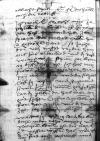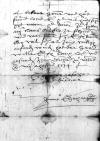Ich hab E(wer) G(nad)e mer malle(n), saÿd ich in Spain (Hispania)⌊Spanÿa(m)Spain (Hispania)⌋ kome(n) pein(n), geschribe(n) und dona Juana Dantisca (*1527 – †1601), daughter of Ioannes Dantiscus and Isabel Delgada; wife of Diego Gracián de Alderete (SKOLIMOWSKA 2004, p. 52; LLAMAS 1995; LLAMAS 1999; LLAMAS 2001; LLAMAS, SKOLIMOWSKA; MELGAR, 37, ...)⌊IuanÿcaJuana Dantisca (*1527 – †1601), daughter of Ioannes Dantiscus and Isabel Delgada; wife of Diego Gracián de Alderete (SKOLIMOWSKA 2004, p. 52; LLAMAS 1995; LLAMAS 1999; LLAMAS 2001; LLAMAS, SKOLIMOWSKA; MELGAR, 37, ...)⌋ halbe(n) mein(e) maÿno(n)g und gut bedonck(en) anzaig(e)t, ouch d(a)z selb montlich mÿt dem Johan Weze (*1490 – †1548), secretary to King Christian II of Denmark; in 1522 nominated Archbishop of Lund; in 1527 was banished from Denmark as Christian II's secretary, and joined the service of Emperor Charles V as his diplomat, 1537-1548 Bishop of Constance (WHALEY, p. 314)⌊electus vo(n) LundaJohan Weze (*1490 – †1548), secretary to King Christian II of Denmark; in 1522 nominated Archbishop of Lund; in 1527 was banished from Denmark as Christian II's secretary, and joined the service of Emperor Charles V as his diplomat, 1537-1548 Bishop of Constance (WHALEY, p. 314)⌋ geret. D(a)z Juana Dantisca (*1527 – †1601), daughter of Ioannes Dantiscus and Isabel Delgada; wife of Diego Gracián de Alderete (SKOLIMOWSKA 2004, p. 52; LLAMAS 1995; LLAMAS 1999; LLAMAS 2001; LLAMAS, SKOLIMOWSKA; MELGAR, 37, ...)⌊thochterleJuana Dantisca (*1527 – †1601), daughter of Ioannes Dantiscus and Isabel Delgada; wife of Diego Gracián de Alderete (SKOLIMOWSKA 2004, p. 52; LLAMAS 1995; LLAMAS 1999; LLAMAS 2001; LLAMAS, SKOLIMOWSKA; MELGAR, 37, ...)⌋ facht an, gros werd(en), und yst zÿt, d(a)z mans vo(n) der Isabel Delgada (†after 1546-06-15), Dantiscus' paramour during his stay in Spain, mother of his two children, Juana and Juan (Juan died in childhood)⌊mutterIsabel Delgada (†after 1546-06-15), Dantiscus' paramour during his stay in Spain, mother of his two children, Juana and Juan (Juan died in childhood)⌋ neme. So mag E(wer) G(nade) die Isabel Delgada (†after 1546-06-15), Dantiscus' paramour during his stay in Spain, mother of his two children, Juana and Juan (Juan died in childhood)⌊mutterIsabel Delgada (†after 1546-06-15), Dantiscus' paramour during his stay in Spain, mother of his two children, Juana and Juan (Juan died in childhood)⌋ mÿt 150 in 200 duc(aten) zu frÿden stelle(n) uff ain(n) mal. Da mÿt wuÿrt Isabel Delgada (†after 1546-06-15), Dantiscus' paramour during his stay in Spain, mother of his two children, Juana and Juan (Juan died in childhood)⌊sÿIsabel Delgada (†after 1546-06-15), Dantiscus' paramour during his stay in Spain, mother of his two children, Juana and Juan (Juan died in childhood)⌋ irrn remedio suche(n). So mocht d(a)z Juana Dantisca (*1527 – †1601), daughter of Ioannes Dantiscus and Isabel Delgada; wife of Diego Gracián de Alderete (SKOLIMOWSKA 2004, p. 52; LLAMAS 1995; LLAMAS 1999; LLAMAS 2001; LLAMAS, SKOLIMOWSKA; MELGAR, 37, ...)⌊tochterleJuana Dantisca (*1527 – †1601), daughter of Ioannes Dantiscus and Isabel Delgada; wife of Diego Gracián de Alderete (SKOLIMOWSKA 2004, p. 52; LLAMAS 1995; LLAMAS 1999; LLAMAS 2001; LLAMAS, SKOLIMOWSKA; MELGAR, 37, ...)⌋ E(wer) G(nade) etwa in geselschafft erlicher frowe(n) und luÿt, so teglich ins The Low Countries (Netherlands), region around the delta of the Rhine, Schelde (Scheldt), and Meuse rivers, includes modern Belgium, the Netherlands, Luxembourg and parts of northern France and western Germany⌊NÿderlandThe Low Countries (Netherlands), region around the delta of the Rhine, Schelde (Scheldt), and Meuse rivers, includes modern Belgium, the Netherlands, Luxembourg and parts of northern France and western Germany⌋ fare(n), da hein gesant werd(en). Das rant ich E(wer) G(nad)e als ain(n) trüewer superinscribed⌈rr superinscribed⌉, gutter gefather, dan es kan nÿt minder(e) sein(n). Die kinder musse(n)d gelt cost(en), das waÿs ich peÿ mier(e) selbs. So ma(n) die arbaÿt nÿmpt, die zu mache(n), so mus ma(n) nach mals geduldt habe(n), den seckel uff ze thun.  AAWO, AB, D. 91, f. 174vr Albrecht Cuon (Kohn) (†after 1559), a German merchant from Nuremberg, and the Welsers' factor in Spain (Oberdeutsche Kaufleute, p. 36, footnote 122)⌊AlbrechtAlbrecht Cuon (Kohn) (†after 1559), a German merchant from Nuremberg, and the Welsers' factor in Spain (Oberdeutsche Kaufleute, p. 36, footnote 122)⌋ cf. Albrecht CUON to Ioannes DANTISCUS Valladolid, 1534-10-12, CIDTC IDL 4248⌊schribtcf. Albrecht CUON to Ioannes DANTISCUS Valladolid, 1534-10-12, CIDTC IDL 4248⌋ E(wer) G(naden) deshalbe(n) ouch die nottorfft.
AAWO, AB, D. 91, f. 174vr Albrecht Cuon (Kohn) (†after 1559), a German merchant from Nuremberg, and the Welsers' factor in Spain (Oberdeutsche Kaufleute, p. 36, footnote 122)⌊AlbrechtAlbrecht Cuon (Kohn) (†after 1559), a German merchant from Nuremberg, and the Welsers' factor in Spain (Oberdeutsche Kaufleute, p. 36, footnote 122)⌋ cf. Albrecht CUON to Ioannes DANTISCUS Valladolid, 1534-10-12, CIDTC IDL 4248⌊schribtcf. Albrecht CUON to Ioannes DANTISCUS Valladolid, 1534-10-12, CIDTC IDL 4248⌋ E(wer) G(naden) deshalbe(n) ouch die nottorfft.
Ich waÿs E(wer) G(nad)e nÿchs nuÿes ze schribe(n). Der Charles V of Habsburg (*1500 – †1558), ruler of the Burgundian territories (1506-1555), King of Spain as Charles I (1516-1556), King of Naples and Sicily, King of the Romans (1519-1530), Holy Roman Emperor of the German Nation (elected 1519, crowned 1530, abdicated 1556); son of Philip I the Handsome and Joanna the Mad of Castile⌊kaÿsserCharles V of Habsburg (*1500 – †1558), ruler of the Burgundian territories (1506-1555), King of Spain as Charles I (1516-1556), King of Naples and Sicily, King of the Romans (1519-1530), Holy Roman Emperor of the German Nation (elected 1519, crowned 1530, abdicated 1556); son of Philip I the Handsome and Joanna the Mad of Castile⌋ ÿst zu Valencia, city in southeastern Spain, on the mouth of the Turia river⌊PalenczValencia, city in southeastern Spain, on the mouth of the Turia river⌋, der hoff hern und her zer spraÿt, des sterbend halbe(n), hie a(n) gefange(n) hant. / So zuÿcht Hendrik III of Nassau-Breda (*1483 – †1538), son of Count Johann V of Nassau-Dillenburg and Elisabeth of Hessen, married to Mencia de Mendoza, Marquess of Zenete, daughter and heiress of Rodrigo Díaz de Vivar y Mendoza, first Marquis of Zenete; Count of Nassau; from 1499 in the service of Archduke Philip of Habsburg as his advisor and military commander in the wars against France and Gueders (1507, 1514), 1515-1522 Stadtholder of Holland and Zeeland; 1521 Grand Chamberlain of Charles V of Habsburg (from 1522 to 1529 at the Spanish court), in 1530 followed Charles V to the coronation in Bologna, and attended the Diet of Augsburg (CE, vol. 3, p. 5)⌊der von NassovHendrik III of Nassau-Breda (*1483 – †1538), son of Count Johann V of Nassau-Dillenburg and Elisabeth of Hessen, married to Mencia de Mendoza, Marquess of Zenete, daughter and heiress of Rodrigo Díaz de Vivar y Mendoza, first Marquis of Zenete; Count of Nassau; from 1499 in the service of Archduke Philip of Habsburg as his advisor and military commander in the wars against France and Gueders (1507, 1514), 1515-1522 Stadtholder of Holland and Zeeland; 1521 Grand Chamberlain of Charles V of Habsburg (from 1522 to 1529 at the Spanish court), in 1530 followed Charles V to the coronation in Bologna, and attended the Diet of Augsburg (CE, vol. 3, p. 5)⌋ wÿder hein aus ins The Low Countries (Netherlands), region around the delta of the Rhine, Schelde (Scheldt), and Meuse rivers, includes modern Belgium, the Netherlands, Luxembourg and parts of northern France and western Germany⌊Nÿder(e)landThe Low Countries (Netherlands), region around the delta of the Rhine, Schelde (Scheldt), and Meuse rivers, includes modern Belgium, the Netherlands, Luxembourg and parts of northern France and western Germany⌋ und d(a)z vast wenÿg tuÿsch, schier(e) gar kaÿner an dÿsse(n) hoff ÿst. Ich hab mein Ursula Meuting daugther of Lucas Meuting, member of the merchant family in Augsburg; from 1530 wife of Ulrich Ehinger (ZELINSKY HANSON, p. 123 and footnote 46; EIRICH, p. 170)⌊frowe(n)Ursula Meuting daugther of Lucas Meuting, member of the merchant family in Augsburg; from 1530 wife of Ulrich Ehinger (ZELINSKY HANSON, p. 123 and footnote 46; EIRICH, p. 170)⌋, E(wer) G(nad)e gefather, hie peÿ mier(e). Ire wil die selczame(n) loff in unsern land(en) regierend, so wil ich im name(n) goz in dÿsse(n) land(en) plibe(n). Da hab wier(e) ain(n) gut, sÿcher, crÿstenlich lebe(n). Got der her welle uns d(a)z lange zÿt mÿt gnad(en) v(er)liche(n).
Wie das in unssern Germany (Germania, Niemcy)⌊land(en)Germany (Germania, Niemcy)⌋ der krieg dorch ander nazio(n) anrÿcht(en) und platique(n) kome(n) ÿst, des mag E(wer) G(nad)e pesser wÿsse(n). Hab(en) wier wd(?) ain(e) fart ouch gestraufft, werd(en)  AAWO, AB, D. 91, f. 175r al bekant herre(n) und gut fre superinscribed⌈ee superinscribed⌉ und lond E(wer) G(nad)e vi(e)l gutzs sage(n). Pÿt Euwer G(nad)e im(m)er zu zÿtten ain(n) clains brieffle ze schribe(n), und war inne(n) ich E(wer) G(nad)e diene(n) kan, wil ich al zeÿt willÿg erfond(en) werd(en). Got der her welle E(wer) G(nade) lang leb(en) und gesund(en) zÿt v(er)liche(n).
AAWO, AB, D. 91, f. 175r al bekant herre(n) und gut fre superinscribed⌈ee superinscribed⌉ und lond E(wer) G(nad)e vi(e)l gutzs sage(n). Pÿt Euwer G(nad)e im(m)er zu zÿtten ain(n) clains brieffle ze schribe(n), und war inne(n) ich E(wer) G(nad)e diene(n) kan, wil ich al zeÿt willÿg erfond(en) werd(en). Got der her welle E(wer) G(nade) lang leb(en) und gesund(en) zÿt v(er)liche(n).
 AAWO, AB, D. 91, f. 174vr
AAWO, AB, D. 91, f. 174vr  AAWO, AB, D. 91, f. 175r al bekant herre(n) und gut fre superinscribed⌈ee superinscribed⌉ und lond E(wer) G(nad)e vi(e)l gutzs sage(n). Pÿt Euwer G(nad)e im(m)er zu zÿtten ain(n) clains brieffle ze schribe(n), und war inne(n) ich E(wer) G(nad)e diene(n) kan, wil ich al zeÿt willÿg erfond(en) werd(en). Got der her welle E(wer) G(nade) lang leb(en) und gesund(en) zÿt v(er)liche(n).
AAWO, AB, D. 91, f. 175r al bekant herre(n) und gut fre superinscribed⌈ee superinscribed⌉ und lond E(wer) G(nad)e vi(e)l gutzs sage(n). Pÿt Euwer G(nad)e im(m)er zu zÿtten ain(n) clains brieffle ze schribe(n), und war inne(n) ich E(wer) G(nad)e diene(n) kan, wil ich al zeÿt willÿg erfond(en) werd(en). Got der her welle E(wer) G(nade) lang leb(en) und gesund(en) zÿt v(er)liche(n).



